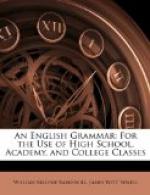116. In the sentences of Sec. 109, we notice that—
(1) That refers to persons, animals, and things.
(2) It has only one case form, no possessive.
(3) It is the same form for first, second, and third persons.
(4) It has the same form for singular and plural.
It sometimes borrows the possessive whose, as in sentence 6, Sec. 109, but this is not sanctioned as good usage.
[Sidenote: What.]
117. The sentences of Sec. 110 show that—
(1) What always refers to things; is always neuter.
(2) It is used almost entirely in the singular.
1. The man that
hath no music in himself,...
Is
fit for treasons, stratagems, and spoils.
—SHAKESPEARE
(3) Its antecedent is hardly ever expressed.
When expressed, it
usually follows, and is emphatic; as, for example,—
What I would, that do I
not; but what I hate, that do
I.—Bible
What fates impose, that men must needs abide.—SHAKESPEARE.
What a man does, that he has.—EMERSON.
Compare this:—
Alas! is it not too true, what we said?—CARLYLE.
DECLENSION OF RELATIVE PRONOUNS.
118. These are the forms of the simple relatives:—
SINGULAR AND PLURAL.
Nom. who which that what Poss. whose whose — — Obj. whom which that what
HOW TO PARSE RELATIVES.
119. The gender, number, and person of the relatives who, which, and that must be determined by those of the antecedent; the case depends upon the function of the relative in its own clause.
For example, consider the following sentence:
“He uttered truths
that wrought upon and molded the lives of
those who heard
him.”
Since the relatives hold the sentence together, we can, by taking them out, let the sentence fall apart into three divisions: (1) “He uttered truths;” (2) “The truths wrought upon and molded the lives of the people;” (3) “These people heard him.”
That evidently refers to truths, consequently is neuter, third person, plural number. Who plainly stands for those or the people, either of which would be neuter, third person, plural number. Here the relative agrees with its antecedent.
We cannot say the relative agrees with its antecedent in case. Truths in sentence (2), above, is subject of wrought upon and molded; in (1), it is object of uttered. In (2), people is the object of the preposition of; in (3), it is subject of the verb heard. Now, that takes the case of the truths in (2), not of truths which is expressed in the sentence: consequently that is in the nominative case. In the same way who, standing for the people understood, subject of heard, is in the nominative case.




